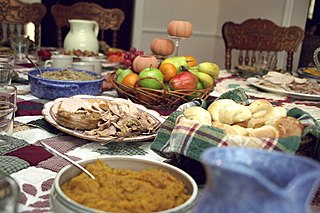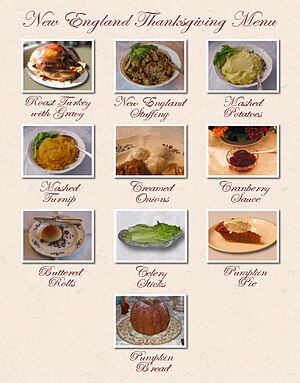Thanksgiving dinner: Difference between revisions
Justitiasana (talk | contribs) |
No edit summary |
||
| Line 68: | Line 68: | ||
*[http://nymag.com/guides/holidays/thanksgiving/40289/ ''The Globalist's Thanksgiving'' New York Magazine] |
*[http://nymag.com/guides/holidays/thanksgiving/40289/ ''The Globalist's Thanksgiving'' New York Magazine] |
||
{{reflist}} |
{{reflist}} |
||
==External links== |
|||
*[http:http://www.mommaworks.com/articles/frugal-ways-to-decorate-your-thanksgiving-table.php Thanksgiving Table] |
|||
{{Thanksgiving}} |
{{Thanksgiving}} |
||
Revision as of 19:27, 13 November 2009

The centerpiece of contemporary Thanksgiving in the United States and Canada is a large meal, generally centered around a large roasted turkey. The majority of the dishes in the traditional American version of Thanksgiving Dinner are made from foods native to the New World, according to tradition the Pilgrims received these foods from the Native Americans. However, many of the classic traditions attributed to the first Thanksgiving are actually myths introduced later.[1]
A very similar dinner is often served on Christmas and New Year's Day.
Historical Menus
The use of the turkey in the USA for Thanksgiving precedes Lincoln's nationalization of the holiday in 1863. Alexander Hamilton proclaimed that no "Citizen of the United States should refrain from turkey on Thanksgiving Day," but turkey was uncommon as Thanksgiving fare until after 1800. By 1857 turkey had become part of the traditional dinner in New England.[2]

A Thanksgiving Day dinner served to the Civilian Conservation Corps in 1935 included: Pickles, green olives, celery, roast turkey, oyster stew, cranberry sauce, giblet gravy, dressing, creamed asparagus tips, snowflake potatoes, baked carrots, hot rolls, fruit salad, mince meat pie, fruit cake, candies, grapes, apples, French drip coffee, cigars and cigarettes.[3]
Customs
Normally a Thanksgiving dinner in the United States bears a good deal of resemblance to another feast served at Christmas: the centerpiece at both is most often a turkey. However, the spirits of these occasions are usually different: the family and friends present at a Thanksgiving table are not expected to give gifts to each other, for example, and the point of the meal is to reflect upon and be thankful for the things that have passed over the last year as well as reconnect with the people one holds close. While most hosts will say a short prayer before the start of the meal, this is not obligatory and there is no overt religious significance to the holiday. (It is not uncommon for people of very different religious backgrounds to gather around the table, e.g., if one's host is Jewish and one is a Christian there is no obligation for either to recite the birkat.)

Turkey
Because turkey is the most common main dish of a Thanksgiving dinner, Thanksgiving is sometimes colloquially called “turkey day″ or “poultry day.” In 2006, American turkey growers were expected to raise 270 million turkeys, to be processed into five billion pounds of turkey meat valued at almost $8 billion, with one third of all turkey consumption occurring in the Thanksgiving-Christmas season, and a per capita consumption of almost 18 pounds.[4]
Most Thanksgiving turkeys are stuffed with a bread-based stuffing and roasted. Sage is the traditional herb added to the stuffing (also called dressing), along with chopped celery, carrots, and onions. Deep-fried turkey is rising in popularity, requiring special fryers to hold the large bird, and reportedly leading to fires and bad burns for those who fail to take care when dealing with a large quantity of very hot oil. In more recent years it is also true that as the wild population of turkeys has rebounded in most of the US, some will hunt and dress their turkey in the woods and then freeze it until meal preparation.
Alternatives to turkey
Non-traditional foods other than turkey are sometimes served as the main dish for a Thanksgiving dinner. Goose and duck, foods which were traditional European centerpieces of Christmas dinners before being displaced, are now sometimes served in place of the Thanksgiving turkey. Sometimes, fowl native to the region where the meal is taking place is used; for example, an article in Texas Monthly magazine suggested quail as the main dish for a Texan Thanksgiving feast. In a few areas of the West Coast of the United States, Dungeness crab is common as an alternate main dish, as crab season starts in early November. Sometimes a variant recipe for cooking turkey is used; for example, a Chinese recipe for goose could be used on the similarly-sized American bird. Vegetarians or vegans may try tofurkey, a tofu-based dish with imitation turkey flavor. In Alaskan villages, whale meat is sometimes eaten.[2] Irish immigrants have been known to have prime rib of beef as their centerpiece as beef was once a rarity back in Ireland; in the past, families would save up money for this as a special sign of newfound prosperity and hope. In the United States, a new globalist approach to Thanksgiving has become popular due to the impact of massive immigration on the country. Some take the basic Thanksgiving ingredients, and reinvent them using flavors, techniques, and traditions from their own cuisines, while others celebrate the holiday with a large festive meal with or without turkey [5].
Given the working holiday it is also common for immigrant communities in North America to participate in the holiday by launching their own celebrations of the holiday. Thus, it is not uncommon to find Chinese, Indian, and other large immigrant communities celebrating Thanksgiving in the same family spirit but with the food of the feast being of their own respective cultures instead.
Side dishes
Many other foods are served alongside the main dish—so many that, because of the amount of food, the Thanksgiving meal is sometimes served midday or early afternoon to make time for all the eating, and preparation may begin at dawn or on days prior.
Traditional Thanksgiving foods are sometimes specific to the day, and although some of the foods might be seen at any semi-formal meal in the United States, the meal often has something of a ritual or traditional quality. Many Americans would say it is "incomplete" without cranberry sauce; stuffing or dressing; and gravy. Other commonly served dishes include winter squash; sweet potatoes; mashed potatoes or rice (in the South and among Asians); dumplings; corn on the cob or hominy; deviled eggs; green beans or green bean casserole; sauerkraut (among those in the Mid-Atlantic; especially Baltimore), peas and carrots, bread rolls, cornbread (in the south and parts of New England), or biscuits, rutabagas or turnips; and a salad. For dessert, various pies are often served, particularly apple pie, mincemeat pie, sweet potato pie, pumpkin pie, chocolate meringue pie and pecan pie, with the last four being particularly American.

There are also non-traditional regional differences as to the stuffing or dressing traditionally served with the turkey. Southerners generally make their dressing from cornbread, while those in other parts of the country make stuffing from white or wheat bread as the base. One or several of the following may be added to the dressing/stuffing: oysters, apples, chestnuts, raisins, celery and/or other vegetables, sausages or the turkey's giblets. The traditional Canadian version has bread cubes, sage, onion and celery. Rice is also sometimes used instead of bread in Canada[citation needed].
Other non-traditional dishes reflect the region or cultural background of those who have come together for the meal. For example, many African Americans and Southerners serve baked macaroni and cheese and collard greens, while some Italian-Americans often have lasagna on the table and Ashkenazi Jews may serve noodle kugel, a sweet dessert pudding. It is not unheard of for Mexican Americans to serve their turkey with mole and roasted corn. In Puerto Rico, the Thanksgiving meal is completed with arroz con gandules (Rice with pigeon peas), pumpkin flan, potato salad , roasted white sweet potatoes and Spanish sparkling hard cider. Cuban-Americans traditionally serve the Turkey alongside a small Roasted Pork and include White Rice and Black Beans or Kidney Beans. Vegetarians or vegans have been known to serve alternative entree centerpieces such as a large vegetable pie or a stuffed and baked pumpkin or tofurkey. Many Midwesterners (such as Minnesotans) of Norwegian or Scandinavian descent set the table with lefse and green bean hotdish.
Beverages
The beverages served at Thanksgiving can vary as much as the side dishes, often depending on who is present at the table and their tastes. Spirits or cocktails occasionally may be served before the main meal. On the dinner table, unfermented Apple cider (still or sparkling) and/or wine are often served. Beaujolais nouveau is sometimes served, as "Beaujolais day" falls one week before American Thanksgiving[6]. For children non-alcoholic beverages are served at the table as it is generally frowned upon (and often illegal) for those below the legal drinking age to consume alcohol, though in some states it is legal for those under 21 to consume alcohol when their parents are present. Pitchers of sweetened iced tea are common throughout the South.
References
- ^ Dickson, J.G. U.S. National Wild Turkey Federation The Wild Turkey pub. Stackpole Books 1992. p. 10
- ^ Davis, Karen More Than a Meal: The Turkey in History, Myth, Ritual, and Reality Lantern Books, 2001. p. 53.
- ^ Smith, K.M. Gold Medal CCC Company 1538: A Documentary Turner Publishing Company, 2001. p. 98.
- ^ Hearings of the Agriculture, Nutrition and Forestry Committee, July 17, 2006
- ^ New York magazine, November 6, 2007 The Globalist's Thanksgiving[1]
- ^ Beaujolais Nouveau: History Behind the Third Thursday in November
External links
- [http:http://www.mommaworks.com/articles/frugal-ways-to-decorate-your-thanksgiving-table.php Thanksgiving Table]
